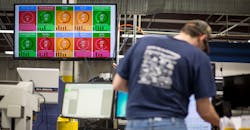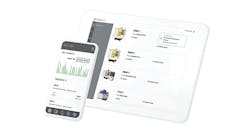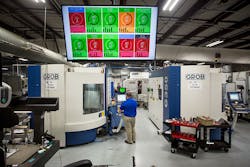Prior to 2016, Carolina Precision Manufacturing, a nondescript machine shop about an hour’s drive north from Charlotte, had 51 machines running constantly to cut and mill components for aerospace and specialized industrial uses. In the morning, an operator would make the rounds at each machine, recording the previous day’s data and then manually entering the numbers into the ERP. That’s an arduous process that may have created three hours a day of dead time for the contract manufacturer.
Then the company, which specializes in CNC Swiss-turn, decided to make the digital plunge and integrated MachineMetrics IIoT analytics platform into the shop’s array of equipment.
“It’s a game changer as far as how we go about our day because with real-time data we can see what’s happening right now and you go and respond and react to that,” says former president Gary Bruner.
“It gives you a much better opportunity to figure out what’s going on and fix the problem as it’s happening.”
Bruner says the manufacturer’s sales lead spent one afternoon with the software and newly collected data to cut dead time and optimize areas in four programs, resulting in a potential 900 hours of production time for the year. This is exactly the type of result CEO Bill Bither and COO Eric Fogg envisioned when they founded MachineMetrics in Northampton, Mass.
Bither had a background in aerospace, while Fogg worked for more than a decade in machine shops. They met in 2010, a time when manufacturers were the ones getting grinded by the recession. Fogg realized inefficiencies were causing his shop to bleed money and insert bottlenecks and set out to do something about it.
“My boss would come down and say, ‘I need to ship 300 of these parts, and we’re already a week late,’” Fogg recalled. “I would say, ‘Well, there’s only 60 of them complete.’”
“What went wrong?” Fogg’s boss would retort angrily.
For Fogg to answer such a complex question wouldn’t be easy.
“The thing about manufacturing, and probably a lot of other industries, is that I could have given him the top 10 reasons why that job was behind, and it wouldn’t have constituted 5% about why it was actually behind,” Fogg shares.
“There’s so much stuff that can happen, so many discrete things that can go on, that there’s really no way you can sit down with your boss and explain why a job is behind.”
Thus he started to foment what would become MachineMetrics to answer the boss’s questions fully, and to switch the question from “what went wrong?” to “what’s going wrong?”
And the key was in the numbers.
Data Desert
“There are thousands of pieces of data that can be pulled from any discrete machine tool every minute, and all that data has value,” Fogg says.
MachineMetrics is one way to help any machine shop, and virtually any machine tool, realize that potential.
The self-installed, cloud-based analytics platform, connects to any type of machine and allows manufacturers to use data to track operational efficiency, understand primary reasons for downtime, measure process improvements, and take action with real-time notifications. The platform has three different subgroups: Production and the recently released Health, and Service.
The challenge for MachineMetrics is to persuade traditional, small manufacturers that they can benefit from big data just the same as the giant tech companies.
“Big data has permeated every other industry, but it’s yet to really take its grasp on manufacturing,” explains Graham Immerman, MachineMetrics’ director of marketing.
“It’s the largest industry in the country with the least amount of digital penetration. There’s never been a bigger opportunity, and no one has really solved it yet.”
The company says its list of satisfied customers is growing rapidly, and the more it gets, the stronger the platform becomes. Based on customer data, MachineMetrics releases benchmarking reports to its clients, who can see how they are doing against their peers and segment that info to the type of machine and industry.
“We might tell ourselves we are the best, but having actual benchmarking data that positions us amongst our peers allows us to back this notion up,” says Jonathan Bicknell, technology manager at Turbocam International in New Hampshire.
“Our question now is no longer where do we stand, but how do we increase our percentile while maintaining employee health—this could justify further automation.”
Context Clues
The platform also fosters better communication between workers through monitors on the shop floor and real-time notifications. The metrics dashboard background is red when production is behind and green if “everything’s perfectly all right now.”
The operator need only look up for a moment to see if he or she needs to adjust to prevent a bottleneck, or if their teammate may need help. And everything is customizable depending on company standards and culture.
“Some companies’ tiles will stay green above 90% production, while others require 100%,” Immerman says.
“A company can customize when notifications get sent out depending on the tiles changing also; when a job falls behind either to orange or red, they can send notifications to specific people to let them know so they can take corrective action in real-time.”
The operators are also crucial to contributing data that AI is not yet advanced enough to understand. If there is a stoppage or fault, the operator at the machine can easily add explanations to provide context the machines cannot, which also gets stored and aggregated to inform future issues.
The production monitoring dashboard also feeds into the C-Suite for executives to understand what’s happening at all times.
“This facilitates proactive and predictive action to not only see what’s going on but to discover improvement opportunities that help increase the bottom line,” Immerman says.
A Massachusetts advanced manufacturer called VSS backs this up, revealing that 10% efficiencies stemming from MachineMetrics became 20% once managers received the data.
“To be 15 to 20% more efficient, in our case, we’ve calculated will save us $1 to 2 million in capital expenditures over the next 3 years,” says VSS president Steve Capshaw.
Deus Ex Data
This is only dwarfed by the level of M2M communication permitted, due to its ability to suck data from PLCs, along with an arsenal of edge gateway devices and 200+ adaptors to ensure even legacy machines can join the data party.
The Carolina Precision example, saving those 900 hours as well as increasing capacity by $1.5 million, is just “low-hanging fruit” to Immerman. He says the average increase in manufacturing efficiency in the first year for their customers is around 20%, and that’s not even factoring in the saved time and costs of internal data infrastructure and uncovering additional inefficiencies.
The newest application on the platform, MachineMetrics Health, allows a new level of clairvoyance for shops, helping them predict, prevent, and even potentially stop machinery before a catastrophic failure.
Service departments can use data to gain insight into customers’ equipment health and condition, identify maintenance opportunities with analytics and reporting, predict and deliver early warning of potential equipment failures, highlight elevated risk areas that lead to machine downtime, or even take preventative action before it impacts a customer’s machine performance.
“This application allows internal and remote maintenance teams to monitor and manage the health of machines in real-time,” Immerman explains.
“Using machine learning, we can predict when certain maintenance issues will arise, when cutting tools are going to reduce quality, or may have a breakage or the tool path may be off. We can then send this info to customers through our alerting engine, which can save them thousands or even millions of dollars a year on quality problems and downtime.”
MachineMetrics data pool will turn into an ocean thanks to its new partnership with The Robert E. Morris Company. Every new Tsugami CNC machine sold by the company’s REM Sales department will have MachineMetrics’ Service application.
“Tsugami/Rem Sales is thrilled to partner with MachineMetrics, bringing cutting edge, disruptive technology directly into our end-users businesses,” explained Michael Mugno, Vice President, Tsugami/Rem Sales.
“The addition of MachineMetrics to our Swiss-turn machine platform packages allows users to collect data on machine health, production status, downtime, and so much more that they may never have known existed—bettering businesses across the industry.”
“By allowing machines problems to be diagnosed and resolved from their service office, we are enabling equipment manufacturers to provide their customers with faster, better service while tremendously reducing the costs of going onsite,” Bither says.
“Our data science team is working closely with the data to deliver optimized preventative and predictive maintenance specific to their machines to improve machine uptime.”
What’s more, OEMs can use all that data to better understand customers and their needs, as well as machine capacity and what causes them to fail. In short, it takes everything from the past and allows you to see the future clearly—well, almost.
“We can tell you with certainty there is a 99% chance of significant downtime,” Immerman says, “Now that’s some powerful stuff.”
About the Author
John Hitch
Editor, Fleet Maintenance
John Hitch, based out of Cleveland, Ohio, is the editor of Fleet Maintenance, a B2B magazine that addresses the service needs for all commercial vehicle makes and models (Classes 1-8), ranging from shop management strategies to the latest tools to enhance uptime.
He previously wrote about equipment and fleet operations and management for FleetOwner, and prior to that, manufacturing and advanced technology for IndustryWeek and New Equipment Digest. He is an award-winning journalist and former sonar technician aboard a nuclear-powered submarine where he served honorably aboard the fast-attack submarine USS Oklahoma City (SSN-723).



